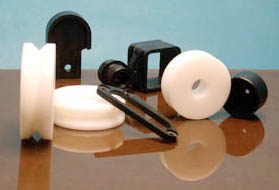Plastic Properties of Acetal
 |
| Bezels, pulley wheels, wear caps and cradles all machined out of black and white Acetal. |
Acetal became commercially available in 1960. Acetal is a by-product of a two-step reaction between an alcohol and an aldehyde. Formed by polymerizing anhydrous formaldehyde to form an oxymethlylene chain. Acetal is a popular and versatile crystalline engineering polymer. It is very strong and exhibits good chemical resistance. Acetal is a tough material with good dimensional stability, and a low coefficient of friction. Acetal machines well and is relativiely easy to process. Typical applications include gears, springs, plates, bushings and housings. Acetal is formaldehyde based and care should be taken when processing; formaldehyde released is a skin and eye irritant.

Dynalab Corp's plastic fabrication shop fabricates many catalog and custom Acetal products. If you can't find the product you require on our website please e-mail for a custom quote.
Don't see the answers to your Acetal questions? It must be time to see what
Mr. Plastic has to say. Mr. Plastic is a wealth of technical, practical and even some hysterical plastic advice. Please submit your request via
e-mail, phone calls will not be accepted.
Acetal Resistance:
|
|
Acetal Quick Facts:
|
Excellent resistance (no attack) to Formaldehyde, Oils and Alcohols
|
|
• Max Temp: 180°F 80°C
• Min Temp: -40°F -40°C
• Autoclavable: No
• Melting Point: 320°F 160°C
• Tensile Strength: 8,800 psi
|
• Hardness: R107
• UV Resistance: Poor
• Opaque
• Rigid
• Specific Gravity: 1.41 |
Limited resistance (moderate attack and suitable for short term use only) to Methylethylketones
|
|
Poor resistance (not recommended for use with) Acids
|
|
| Acetal Fabrication: |
|
Additional Information:
|
• Highly machinable
• Excellent for mechanical parts
• Pulleys, sheaves, bearing surfaces
• Gears, bushings, shafts
• Wear resistant surfaces
• Excellent rigidity
|
|
• Chemical Properties A-F
• Chemical Properties G-Z
• Physical Properties
• Use and Care of Plastics
The downloads above are
Adobe PDF files and require
Adobe Acrobat Reader
|
|
|